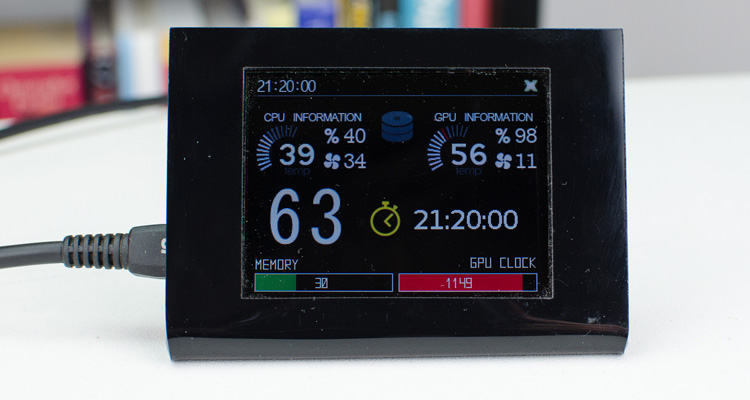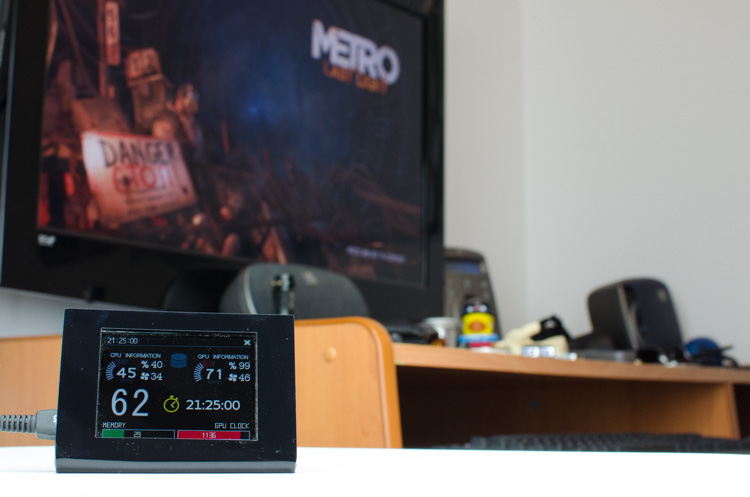As a PC builder and gamer I find it fun and incredibly interesting to tinker around with my set-up, whether that's buying a new graphics card to improve its speed, fiddling with the cooling to ensure everything can run smoothly, or overclocking to squeeze out some extra performance. I monitor many things, from the temperature of my CPU and its fan speed, to the frames per second and GPU load in games, just to see how capable my PC really is.
Traditionally I'd use a bunch of programs to monitor all these stats, including SpeedFan and Fraps, gathering info through pop-ups or windows on a second monitor. Then I was sent an LCDSysInfo - a small 2.8-inch LCD gadget that can be configured to show various stats - and monitoring my PC became significantly easier.
If you haven't heard of the LCDSysInfo don't be surprised, it's the relatively unknown project of a Hong Kong-based hardware development team (ColdTears Electronics), and software developer Ezequiel Gonzalez. Originally the unit was sold just to developers for various uses, although Gonzalez wanted to display gaming related stats on it, and so started his own side-project. Purposing software called GOverlay, the system could be transformed into a remarkably handy gaming companion, and after enough work the team decided to sell this version to the general public.
The device itself is pretty simple: it consists of a curved piece of plastic, to which a 2.8-inch display and logic board are attached. The only port is a mini-USB port on the left-hand side, which attaches to your PC via a provided cable to deliver power and data. The entire unit is pretty rudimentarily constructed, but it works as desired, and when you set it up you don't really need to touch it later.
Display-wise the LCDSysInfo has a 2.8-inch TFT LCD at 320 x 240, capable of 262K colors. As you can tell this isn't the best display going around, and in usage there is considerable backlight bleed and low contrast. Luckily the screen doesn't need to be fantastic, as it's only going to display static gadgets as opposed to photos and other visuals, and costs can be kept down by not using premium components.
Setting up the device is definitely not for the faint hearted. For a start, you'll need a range of 3rd party applications to take full advantage of the GOverlay software, as it not only uses its own set of plugins, but it also pulls data from other sources. As recommended, alongside GOverlay I installed Open Hardware Monitor, which provides a range of PC statistics, as well as the Rivatuner Statistics Server (RTSS), that provides an FPS counter and automatic game detection. Installing and configuring all three of these programs gives the LCDSysInfo a huge range of data to utilize, and although GOverlay can be used by itself, it's the 3rd party applications that enhance the package.
The way LCDSysInfo displays the data gathered by GOverlay is through widgets, and you can store two widget configurations - one for gaming and one for general PC use - that automatically switch between each other (provided you have RTSS installed). In the configuration window you select widgets from the right pane, and they're added to a panel in the center corresponding to the section of the LCDSysInfo's display they'll occupy. You can configure and move around each of these widgets at will, and as soon as you click Save and Apply, the LCD panel will refresh with your new setup.
The configuration settings have their upsides and downsides. The LCDSysInfo is highly customizable, and you'll likely spend hours customizing your setup to get it just right. Information is gathered from everywhere, and each widget, graph or chart can be manipulated to the way you want. However, the process is fiddly and can be complicated, so if you want a visually appealing configuration, expect to spend a lot of time perfecting the look through changing minor elements. GOverlay also does little to guide you through the process of configuring widgets, leaving a lot to trial, error and guessing.
Despite the complications of setting up and configuring the LCDSysInfo, the end results are exactly as I was hoping for. Information about CPU and GPU temperatures, load and fan speeds; RAM and disk usage; and (in games) a frames per second counter are all seen at a quick glance. I can easily make sure my PC's temperatures are in a safe range at all times when overclocking, and I can see how smooth my games are running. The device is perfectly fit for the task, and makes a great companion for the enthusiast PC gamer.
It's also great to know that the system is still receiving regular developer attention, having been updated countless times since its launch a few months ago. In the time since I've had the unit I've updated the software five times, and seen a major UI overhaul, new features added such as plugin support (which extends the customizability for dedicated developers), and improvements to stability. Not only that, but there's a promise of more to come, with Gonzalez informing me that support for specialized widgets for racing games is currently in testing, among other things.
While the package is a little rough around the edges, the $32 you pay for the LCDSysInfo for GOverlay is a device with a lot of functionality, and a lot of potential for even more awesome applications. It's designed for the enthusiast and it'll take an enthusiast to configure it, but once the setup is just right, it provides handy info for gamers at a glance.
score
Pros: Provides quick information at a glance, highly customizable through widgets and plugins, continually being developed. Oh, and it's $32!
Cons: It's complicated and time-consuming to configure, rudimentary construction from somewhat cheap components




